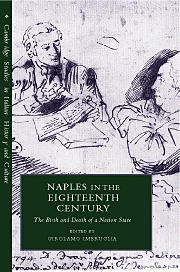Book contents
- Frontmatter
- Contents
- List of abbreviations
- Introduction
- 1 The capital and the provinces
- 2 The Court: power relations and forms of social life
- 3 The arrogance of the market: the economy of the Kingdom between the Mediterranean and Europe
- 4 Enlightenment in eighteenth-century Naples
- 5 The feudal question, judicial systems and the Enlightenment
- 6 Intellectuals and academies
- 7 Music and Enlightenment
- 8 Antiquarian studies in Naples at the end of the eighteenth century. From comparative archaeology to comparative religion
- 9 How not to finish a revolution
- Bibliography
- Index of names
- CAMBRIDGE STUDIES IN ITALIAN HISTORY AND CULTURE
8 - Antiquarian studies in Naples at the end of the eighteenth century. From comparative archaeology to comparative religion
Published online by Cambridge University Press: 14 October 2009
- Frontmatter
- Contents
- List of abbreviations
- Introduction
- 1 The capital and the provinces
- 2 The Court: power relations and forms of social life
- 3 The arrogance of the market: the economy of the Kingdom between the Mediterranean and Europe
- 4 Enlightenment in eighteenth-century Naples
- 5 The feudal question, judicial systems and the Enlightenment
- 6 Intellectuals and academies
- 7 Music and Enlightenment
- 8 Antiquarian studies in Naples at the end of the eighteenth century. From comparative archaeology to comparative religion
- 9 How not to finish a revolution
- Bibliography
- Index of names
- CAMBRIDGE STUDIES IN ITALIAN HISTORY AND CULTURE
Summary
When, in February 1781, William Hamilton discovered evidence of the practice of a phallic cult in the church of Saints Cosmas and Damian in the city of Isernia, he had no doubt that this would revolutionise the history of religion in its relation to archaeology and popular traditions. Ever since Luther, Protestant theologians had been in the habit of asserting that the corruption of the Catholic church had turned Christans away from the Gospel and that the ‘Whore of Babylon’ harboured every possible pagan excess. They were not, however, concerned to establish direct historical links between the church of Rome and paganism, only to demonstrate that by moving away from the Gospel message, the church was betraying Christian docrine. The aim of Hamilton, and of his correspondents and friends, was quite different. These antiquarians, collectors and patrons, members of respectable London society, were involved in an enterprise of a philosophical rather than a theological nature. Unlike their seventeenth–century forebears, they were not antiquarians interested purely in the acquisition, description and classification of curiosities. Their enthusiasm encompassed both antiquities and popular customs, for it arose from a desire to understand the man behind the object. They were thus in a real sense Enlightenment figures, though a number of their contemporaries (some of them very eminent) were convinced that the study of antiquity bore no relation whatever to true philosophical inquiry.
- Type
- Chapter
- Information
- Naples in the Eighteenth CenturyThe Birth and Death of a Nation State, pp. 154 - 166Publisher: Cambridge University PressPrint publication year: 2000
- 2
- Cited by

